Homemade Sourdough Bagels – With Video
Sourdough bagels are chewy, crusty and properly dense. They have an extra deep flavor thanks to the sourdough starter in the recipe. This recipe take more than 12 hours to make, but the vast majority of the time is hands-off.

I’ve said it before, I think a good bagel should have a nicely dense and chewy texture with a toothsome crust. Forget the frozen hockey pucks from the grocery store, and the bagels from chain bakeries that are way too fluffy to be a real bagel.
Homemade bagels are not hard to make and they freeze beautifully. If you set aside a little time over a weekend, you can stock up the freezer for weeks to come.
This Sourdough Bagel recipe is a variation of my popular recipe for New York Style Bagels.
If you don’t already have one, I can show you how to make a sourdough starter and how to feed a sourdough starter.
Ingredients
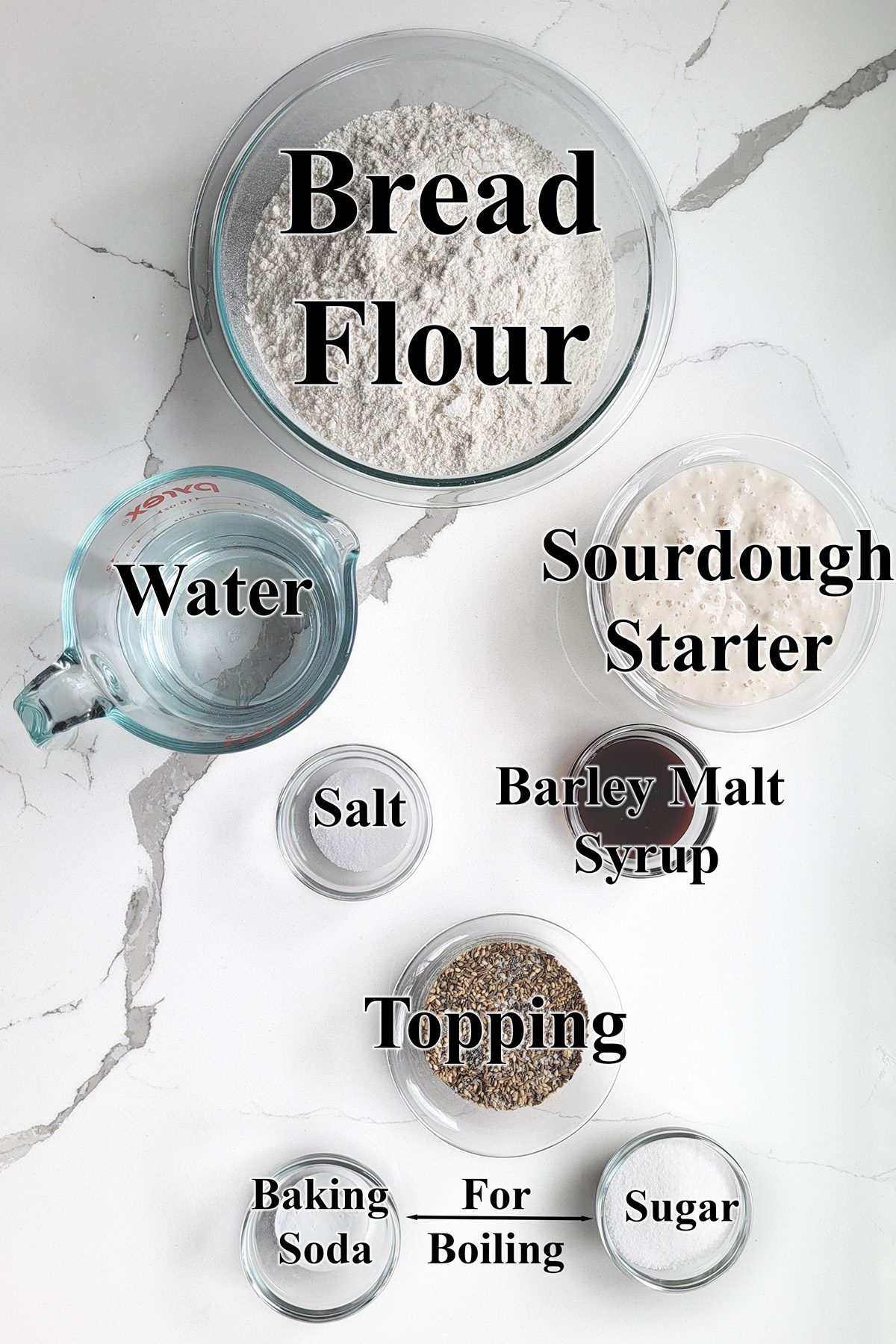
Ingredient Notes
- Bread Flour – Bagels should have a very chewy crumb from a strong gluten network in the dough. High protein bread flour develops plenty of gluten.
- Sourdough Starter – The recipe was developed using 100% hydration starter. You will need to adjust the liquid or flour in the recipe if you’re starter isn’t at 100% hydration. Your starter should be fed and active when you mix the bagel dough.
- Barley Malt Syrup – Adds a traditional slightly sweet note to the dough. You can substitute honey or a combination or honey and molasses for the barley malt syrup.
- Toppings – Leave the bagels plain or use your favorite seed for topping. You can mix seeds with salt to make your own “everything” bagel topping”. See the recipe card for details.
- Baking Soda & Sugar – For boiling the bagels. The boiling process creates the specific shiny and chewy bagel crust.
Process photos for making Sourdough Bagels
See the recipe card for detailed measurements and instructions.
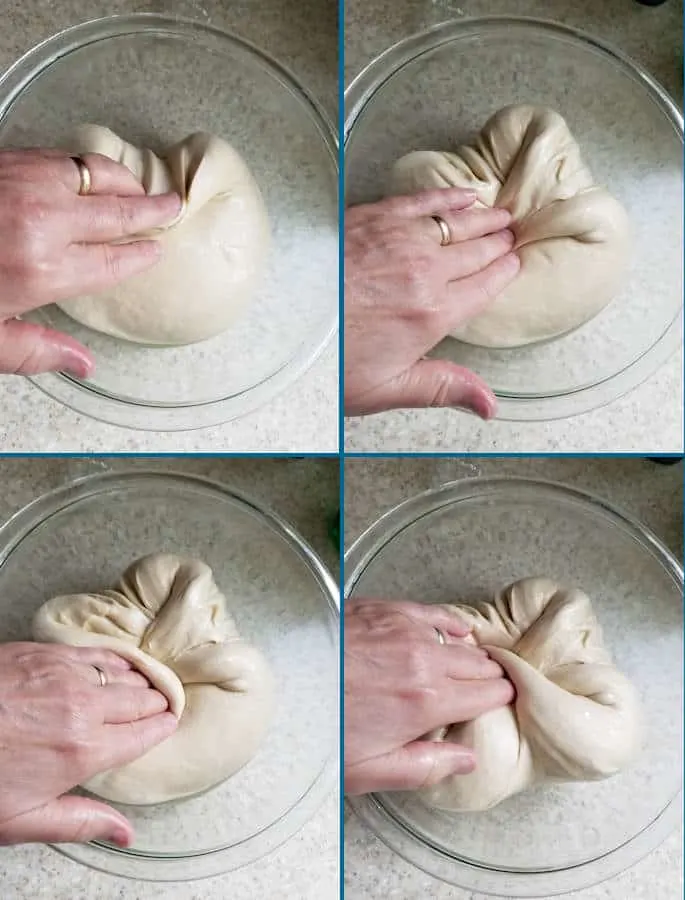
- As the dough ferments, it should be folded onto itself every hour or so to redistribute the yeast.
- Fold from each side into the middle, then flip the dough over.
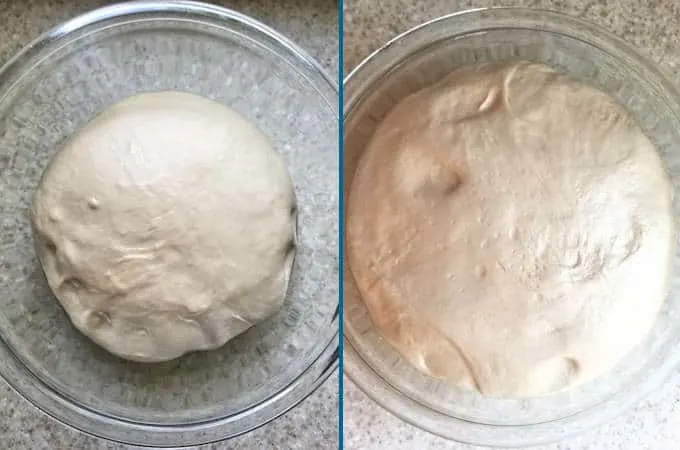
- After 30 minutes there’s not much activity in the dough (left).
- After 3 hours the dough should be active and nicely aerated (right).
- After fermentation it’s time to shape the bagels.
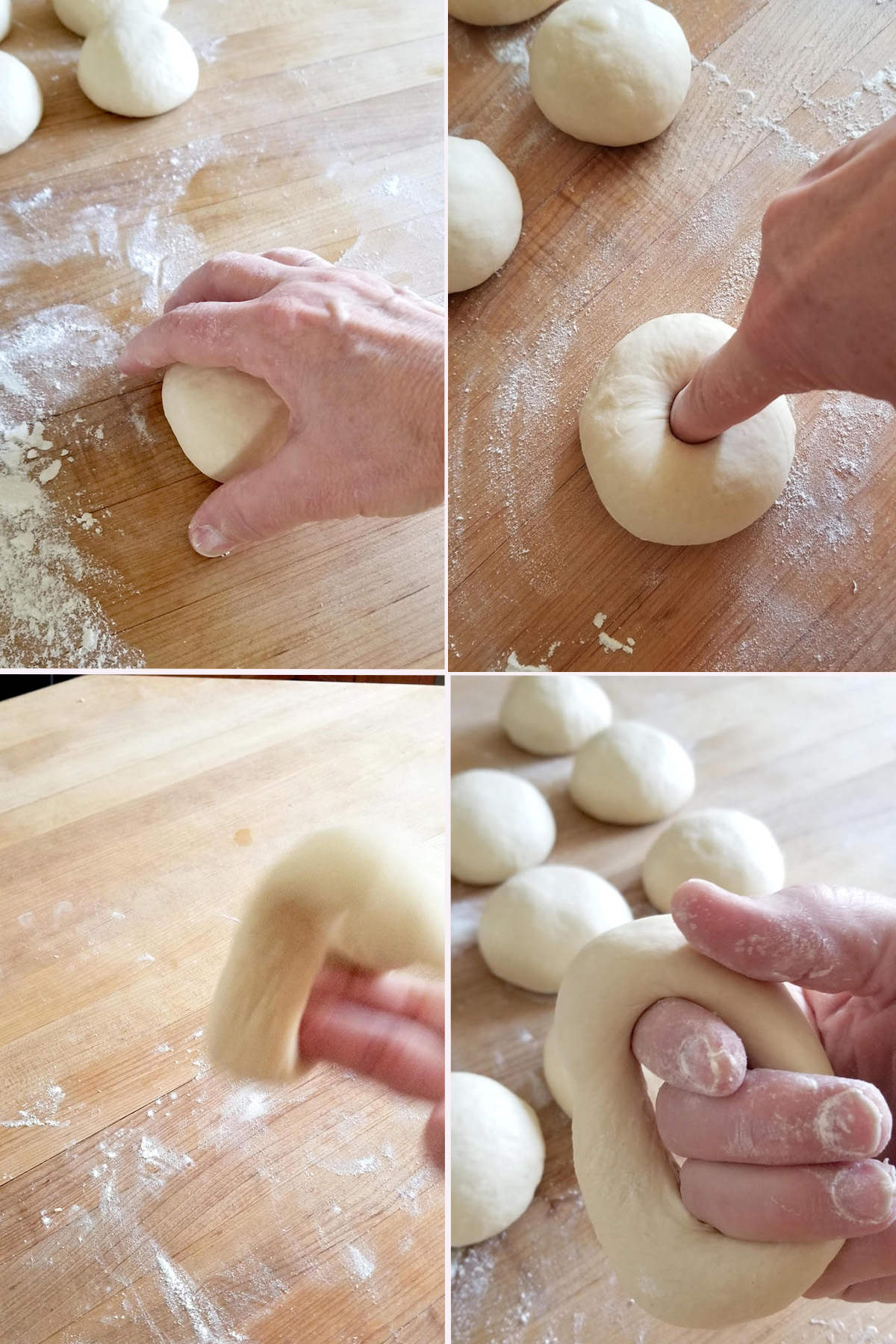
- Use a cupped hand to form the a piece of dough into a tight ball. Repeat with all the pieces of dough.
- Poke your finger all the way through the center of the ball to make a hole.
- Twirl the dough around your fingers to widen the center hole.
- Set the bagel onto the baking sheet and continue with the rest of the dough.
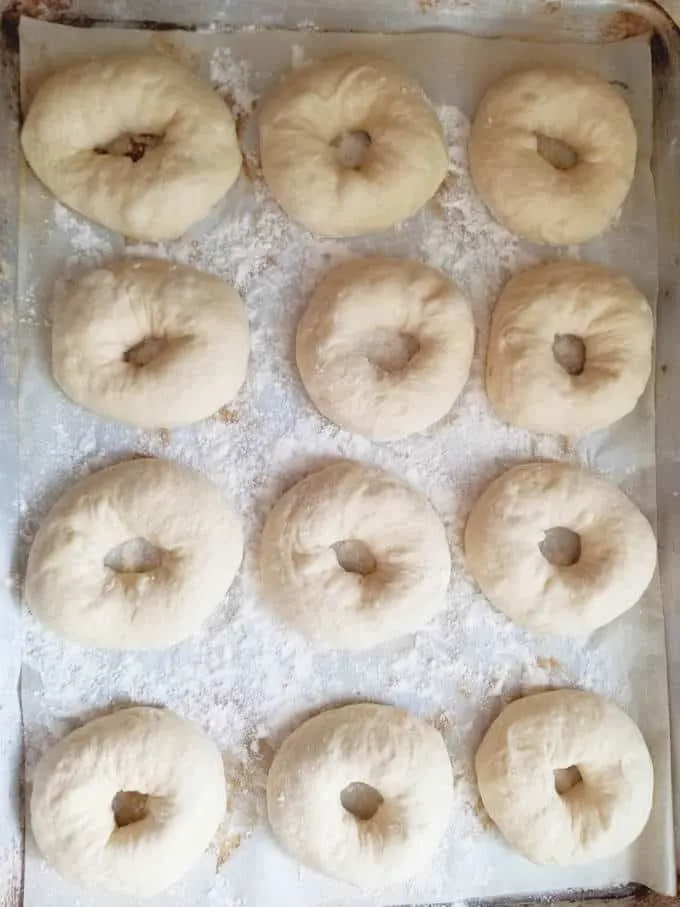
- Line the formed bagels onto a well-floured (or use cornmeal) sheet pan to prevent sticking.
- Cover the pan and place it in the refrigerator overnight.
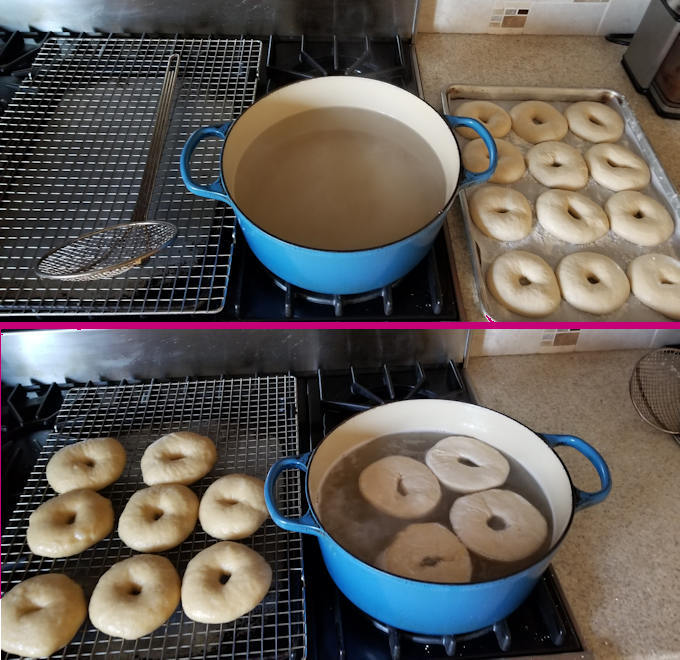
- Bring a pot of water with baking soda and sugar to a boil. Preheat the oven.
- Boil the bagels a few at a time, flipping them every thirty seconds. Boil each batch for 2 minutes.
- Transfer the bagels to a rack to drain while you finish boiling the rest of the bagels.
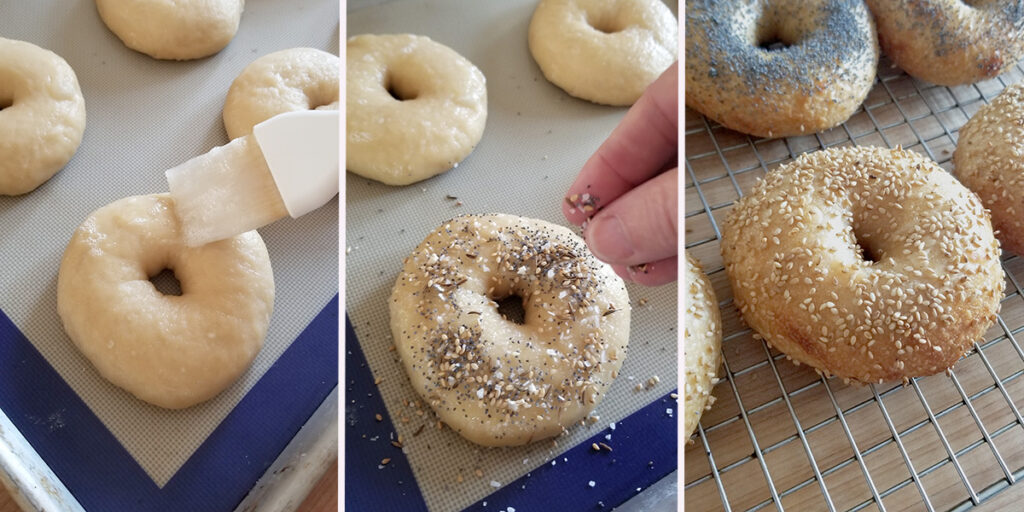
- Brush the boiled bagels with egg white.
- Sprinkle seeds or bagel topping if desired.
- Bake until the bagels are golden brown.
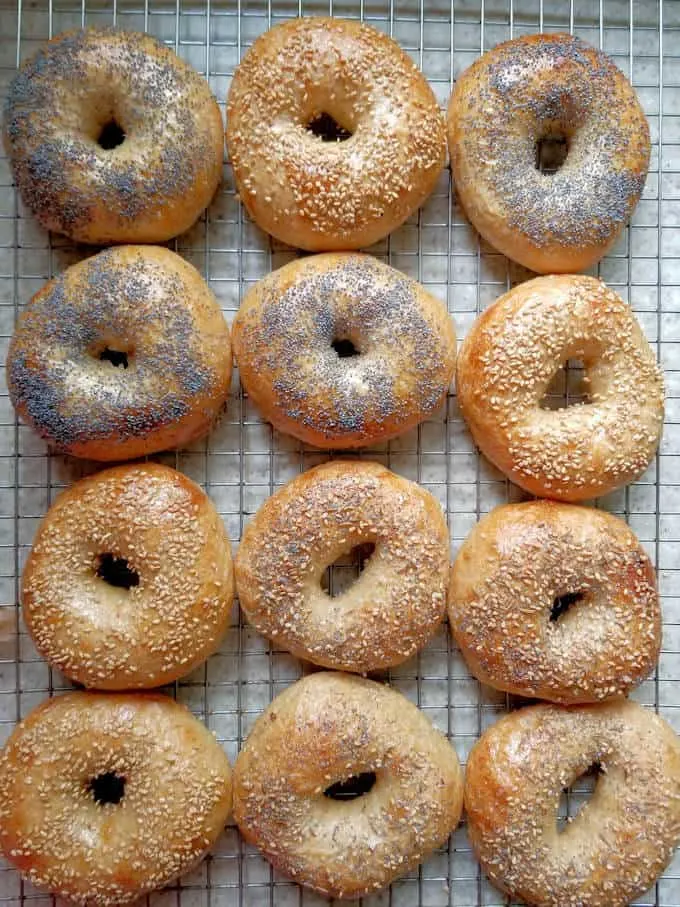
Recipe Tips
- Make sure your starter is very active and lively. I get the best results when I do two feedings in the days before making this dough. I keep several starters and use the Small Starter for this recipe because it requires two feedings before baking with it.
- To get a good bagel shape that will rise properly, you must create a tight ball of dough before making the ring. Use a cupped hand and surface friction to roll the dough into a ball. You can see how it’s done in the recipe video.
- Place the shaped bagels on sheet pan which has been sprinkled liberally with cornmeal or flour. If the bagels stick to the pan you will loose volume when transferring them to the water. I find cornmeal works best, but flour will work too.
- In the morning, take the bagels out of the fridge and leave them out until the dough comes to room temp.
- Don’t start boiling the bagels until the oven is preheated. They should go into the oven within minutes of coming out of the water.
Storage
- Bagels are best the day they are baked. For longer term storage, slice the bagels about 3/4 the way through and pack them into freezer bags.
- Previously frozen bagels are best if toasted before serving.
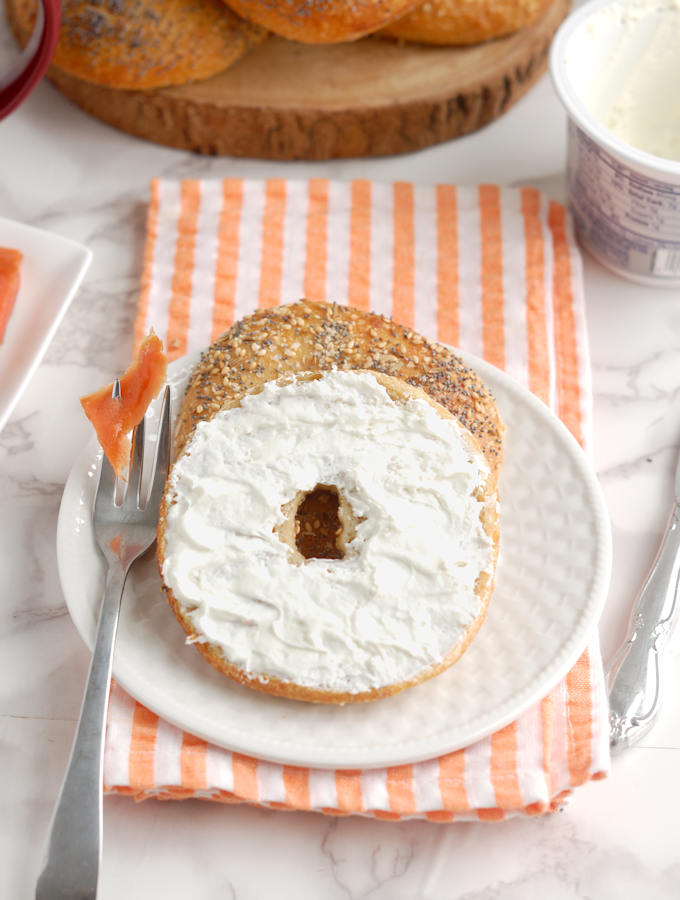
I know you hate to throw away that sourdough discard. Check out these recipes that use sourdough discard.
If you love this recipe as much as I do, please consider giving it a 5-star review.
Sourdough Bagel Recipe
Ingredients
- 8 oz active sourdough starter (1 cup (100% hydration))
- 12 oz warm water (1 ½ cups)
- 22 ½ oz bread flour (4 ½ cups, divided, see note)
- 1 ½ oz barley malt syrup (2 tablespoons (or honey + molasses))
- 1 tablespoon table salt
- 2 oz granulated sugar (¼ cup (for boiling))
- 2 teaspoons baking soda (for boiling)
- corn meal (for pan prep)
- 1 egg white (whisked lightly)
- Topping (sesame seeds, poppy seeds, caraway seeds or coarse salt)
Instructions
- Combine 8 oz active sourdough starter, 12 oz warm water and 2 cups (10 oz) of the flour in a mixing bowl. Mix to form a thick batter. Cover the bowl and set aside for 30-60 minutes.
- Add 1 ½ oz barley malt syrup and 1 tablespoon table salt. Switch to the dough hook. Add the remaining 2 ½ cups (12 ½ oz) flour and mix to combine. The dough should eventually cling to the hook and start to clear the sides of the bowl.
- Knead 5 minutes on medium speed. If working by hand, stir in as much of the flour as you can, then turn the dough out onto a lightly floured surface and knead in the remaining flour. Knead 5 minutes. Form the dough into a smooth ball.
- Put the dough into a lightly oiled bowl, turning once to coat the dough. Cover the bowl and set it aside at room temperature. After 30 minutes uncover the bowl, lift one side of the dough and fold it into the middle of the dough. Repeat with the other three sides of the dough then flip the dough over. You're basically turning the dough inside-out to redistribute the yeast. Cover the bowl and repeat the procedure every 60 minutes for a total fermentation time of about 3 hours. The dough should be lively, elastic and airy. If the dough is still sluggish give it another hour or two at room temperature.
- Line a baking pan with parchment paper then generously sprinkle the paper with cornmeal (or flour). Turn the dough out onto a lightly floured surface without kneading out the air. Divide the dough into 10 even pieces. Use a cupped hand to roll each piece into a smooth, tight ball.
- To form a bagel, poke your finger all the way through the center of a ball to make a hole. Use two fingers to gently open up the hole. Continue gently stretching to form the bagel or twirl the dough around your fingers to widen the center hole to 1 – 1½" wide.
- Place the bagel on the prepared sheet pan and continue to form the remaining bagels. The dough will probably spring back a bit so you can go back and re-stretch the holes once you're done forming all the bagels. Cover the pan with plastic wrap. If the dough and the ambient temperature is on the cooler side, leave the shaped bagels at room temperature for 30 minutes then place the pan in the refrigerator overnight. If the dough and ambient temp is warmer and the dough is quite active, place the bagels into the refrigerator without leaving them out for 30 minutes.
- In the morning take the bagels out of the refrigerator and bring them to room temperature.
- Preheat the oven to 450 °F. In a large pot combine 1 gallon of water with 2 oz granulated sugar and 2 teaspoons baking soda and bring it to a boil. Reduce the heat to keep the water at a rolling simmer. Set a cooling rack over a sheet pan or kitchen towel and place it next to the stove. Line two half-sheet pans with parchment paper or silicone baking mats and generously sprinkle with corn meal.
- Once the oven is preheated, you're ready to boil. Gently lift a bagel off the sheet pan and lower it into the water, bottom side down. Depending on the size of your pot, you can boil 3-4 bagels at a time. Boil the bagels for 30 seconds then flip them. Boil the other side for 30 seconds. Repeat the process again for a total of 2 minutes boiling time. Remove the boiled bagels from the water and set them on the cooling rack to drain.
- Place 5 of the boiled bagels on each sheet pan. You could fit them all on one pan but they may stick together as they bake.
- Brush the bagels with egg white. Add the topping(s) of your choice. To make "everything" bagels combine a tablespoon of each of sesame seeds, poppy seeds & salt with a 1/8 teaspoon garlic powder and onion powder. Bake until golden brown, about 20 minutes.
Would you like to save this recipe?
As an Amazon Associate and member of other affiliate programs, I earn from qualifying purchases.









Hi! I’m wondering if you’ve ever used this recipe as the foundation for cinnamon raisin bagels? If so, what did you change? Thanks!
Yes, I have. I just added cinnamon to the dough and kneaded in raisins before shaping the bagels.
Hi Eileen-
First off this recipe has been SUCH a hit in our household. I’ve made it so many times throughout the past year.
However the last few batches I’ve made have fallen a bit flat. I do know a few steps I need to do differently, but I’m not sure if I’m getting the dough to the right texture when I’m kneading by hand. Should it be at all sticky still? I’m worried about over working it, so I knead it until it becomes a smooth ball, but it is normally still slightly sticky. And then it’s just not getting quite as air-y as it looks in your video. I’ve been trying to keep it in a warmer environment this go around to see if it helps!
Hi Adya, I find that with this recipe so much depends on the condition of my starter when I make the dough. I’ve started using my small starter for the bagels. That starter requires a double feeding before I can use it so it’s always really active when I mix the dough. I would worry less about kneading since a lot of the gluten development happens during the fermentation. In cooler weather the fermentation can take longer.
I tried again yesterday! I did a double feed, and it seemed very active when I first made the sponge. And I gave the fermentation quite a bit more time. The shape of the bagels seemed good when I let them sit out for 30/35 minutes before putting them in the fridge overnight. But they did seem to flatten overnight a bit.. there were still loads of air bubbles that appeared as I let them get to room temp and when I boiled them, but they never got a great raise.
Should I let them sit out longer before putting them in the fridge?
Also since I didn’t have cornflour I used oil to prevent them from sticking, wasn’t sure if that could cause the problem either?
I also just read your comment down below and realised that possibly my bagels are overproofed since they are quite soft, so they stretch a bit as I try to move them from the tray into the oven.
That sounds reasonable. Also, oiling the pan will probably make the bagels adhere just a bit as you lift them, which might cause them to deflate a little. If you don’t have cornmeal, flour would be the next best option instead of oil.
I made these today. They came out very good! Not perfect, but these are the best bagels I’ve made. I have been struggling with bagels. My goal is to replicate the excellent bagels from the bakery at my local whole foods. These had a nice crispy outer layer that the WF bagels don’t have, and I think I prefer it. They were a little more dense than I wanted, one thing I always struggle with is having the bagels collapse, either from transferring them to the boiling water, or after I take them out. I think that’s from overproofing (?). A few questions:
* Any suggestions for how to know when they’re proofed enough to retard in the fridge? I saw another recipe online that said to give them a “float test”. If a bagel floats within 10 seconds after putting in a pot of cold water, it’s ready to retard. Ever try that? Seems like a good idea. I need some kind of quantitative test, it’s impossible to exactly replicate the timing of a recipe because of differences in room temp and the healthiness of the starter.
* Ever try making them bigger? These are a bit too small. They came out to 85g each, the WF ones are 125g each. My concern is that they will be even more difficult to retain their shape if they’re bigger and heavier.
* Do you still do the egg wash if you’re not putting any toppings on?
* These sunk to the bottom of the pot when boiling. I’ve never had that happen before. Is that bad? Good? Indifferent?
* If they sink, do you still boil for the full minute? Since they’re not floating, both sides are getting boiled and there’s no need to flip them.
Hi Dave, sorry for the delayed response. I was making bagels this morning and realized I never answered your questions.
*I find that leaving them at room temperature for 30 minutes before putting them in the fridge for the night gives them a bit of a head start and they usually have a nice little rise by the next morning. With bagels I tend to error on the side of not overproofing since you will have the potential for them to collapse if they are too soft when you transfer them to water for boiling. What works best for me (and I just did this again this morning and got gorgeous bagels) it to take the bagels out of the fridge and leave them out to warm up while I boil the water and preheat the oven. They are still a bit cold when they go into the water, but puff nicely as they boil.
*You could make them bigger. I weigh my raw dough to 105g per bagel. You could weigh the dough and divide by 10 or 8 instead of 12 for bigger bagels.
*I like the shiny crust from the egg white. But I know folks who are vegan who skip the egg glaze.
*Mine do sink when I put them in the water. When they float to the top (after 10-15 seconds) I flip them and boil the other side. I give them another flip or two until they are nice and puffy.
*As I said, mine sink and then float. I like to flip them because I do want them to get even heat on both sides.
Hello, I’m planning on making these today but am confused at the other comments. I tried my first bagel this week and was blown away and decided I would make one and just so happened to have a starter I’ve been feeding. I am wondering if there is any difference to these and normal bagels and if so what. Sorry it’s a bit of a strange question
The difference between sourdough bagels and “normal” bagels is that the dough is leavened using the natural yeast in the starter rather than a commercial yeast. Natural yeast takes longer to rise the dough. The long and slow rise changes the texture and flavor of the dough.
Do you think I could half both recipes so do half this one and half your normal nyc bagels so I can compare them?If so that would be ideal!
Sure, no reason you couldn’t. Although they freeze really well so you could do a full batch of each and freeze leftover.
What are some alternatives to using malt syrup? Honey only, maple syrup, brown sugar, others? And quantities.
Thank you.
The best substitution would be a combination of molasses and honey, a tablespoon of each. Maple syrup would add a distinctive flavor that isn’t very bagelish.
Hi there, So I have a starter that I feed once a week and is kept in the fridge, what would you recommend me doing if I won’t to do this bagel recipe on the day it is due to be fed so 6-7 days after it’s last feeding. Also is black treacle okay to use instead of molasses. Thank you if you can help I’m looking forward to making this recipe!
This recipe gets the best results with a well-fed and very active starter. If your starter hasn’t been fed in a week I would take it out the night before and give it a feeding before making the bagels. If you plan to do the overnight refrigeration step you can feed the starter early in the morning and make the dough early in the afternoon. Here are some great recipes to use up the discard from feeding the starter.